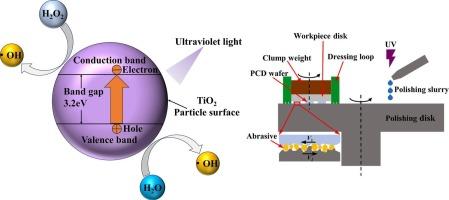紫外光催化辅助单晶金刚石化学机械抛光工艺的实验研究
IF 5.1
3区 材料科学
Q2 MATERIALS SCIENCE, COATINGS & FILMS
引用次数: 0
摘要
单晶金刚石(SCD)是一种新兴的第四代半导体材料,具有超宽带隙和优异的导热性。然而,SCD极高的硬度、优异的耐磨性和强大的化学惰性对实现高质量和高效率的抛光提出了重大挑战。本研究采用紫外光催化辅助化学机械抛光方法加工单晶金刚石。在紫外光照射下,H2O2与TiO2共同作用产生·OH,可使SCD表面氧化形成较软的氧化层,降低抛光难度。通过单因素实验研究了化学工艺参数(H2O2浓度、光强和TiO2浓度)和机械工艺参数(抛光压力、抛光盘速度、磨料浓度和磨料粒度)对SCD抛光效果的影响。实验结果表明,随着H2O2浓度、TiO2浓度、抛光压力、抛光盘转速、磨料浓度、磨料粒度的增加,SCD的材料去除率(MRR)先增大后减小,表面粗糙度(Sa)先减小后增大。MRR与光强的增加呈正相关,而表面粗糙度呈反比关系。在1.5 kg抛光压力、60 r/min抛光盘速度、3 wt%磨料浓度、1 μm磨料粒度、100 mW/cm2光强、10 wt% H2O2和3 g/L TiO2条件下,抛光60 min后,SCD的MRR达到321 nm/h,表面粗糙度为Sa 0.340 nm。本研究为紫外光催化反应在SCD化学机械抛光领域的应用提供了额外的基础依据。本文章由计算机程序翻译,如有差异,请以英文原文为准。

Experimental study on UV photocatalytic assisted chemical mechanical polishing process for single-crystal diamond
Single-crystal diamond (SCD), with its ultra-wide bandgap and exceptional thermal conductivity, is an emerging fourth-generation semiconductor material. However, the extreme hardness, superior wear resistance, and strong chemical inertness of SCD pose significant challenges for achieving both high-quality and high-efficiency polishing. This study employs an UV photocatalytic assisted chemical mechanical polishing approach to process single-crystal diamond. Under UV light irradiation, H2O2 and TiO2 work together to produce ·OH, which can oxidize the surface of SCD to form a relatively soft oxide layer to reduce the difficulty of polishing. The effects of chemical process parameters (H2O2 concentration, light intensity and TiO2 concentration) and mechanical process parameters (polishing pressure, polishing disc speed, abrasive concentration and abrasive particle size) on the polishing effect of SCD were studied by single factor experiment. The experimental results demonstrate that with increasing H2O2 concentration, TiO2 concentration, polishing pressure, polishing disc speed, abrasive concentration, and abrasive particle size, the material removal rate (MRR) of SCD first increases and then decreases, while the surface roughness (Sa) first decreases and then increases. The MRR exhibits a positive correlation with increasing light intensity, while the surface roughness demonstrates an inverse relationship. Under the conditions of 1.5 kg polishing pressure, 60 r/min polishing disc speed, 3 wt% abrasive concentration, 1 μm abrasive particle size, 100 mW/cm2 light intensity, 10 wt% H2O2, and 3 g/L TiO2, the MRR of SCD reached 321 nm/h with a surface roughness of Sa 0.340 nm after 60 min of polishing. This study provides additional fundamental evidence for the application of UV photocatalytic reactions in the field of chemical mechanical polishing of SCD.
求助全文
通过发布文献求助,成功后即可免费获取论文全文。
去求助
来源期刊

Diamond and Related Materials
工程技术-材料科学:综合
CiteScore
6.00
自引率
14.60%
发文量
702
审稿时长
2.1 months
期刊介绍:
DRM is a leading international journal that publishes new fundamental and applied research on all forms of diamond, the integration of diamond with other advanced materials and development of technologies exploiting diamond. The synthesis, characterization and processing of single crystal diamond, polycrystalline films, nanodiamond powders and heterostructures with other advanced materials are encouraged topics for technical and review articles. In addition to diamond, the journal publishes manuscripts on the synthesis, characterization and application of other related materials including diamond-like carbons, carbon nanotubes, graphene, and boron and carbon nitrides. Articles are sought on the chemical functionalization of diamond and related materials as well as their use in electrochemistry, energy storage and conversion, chemical and biological sensing, imaging, thermal management, photonic and quantum applications, electron emission and electronic devices.
The International Conference on Diamond and Carbon Materials has evolved into the largest and most well attended forum in the field of diamond, providing a forum to showcase the latest results in the science and technology of diamond and other carbon materials such as carbon nanotubes, graphene, and diamond-like carbon. Run annually in association with Diamond and Related Materials the conference provides junior and established researchers the opportunity to exchange the latest results ranging from fundamental physical and chemical concepts to applied research focusing on the next generation carbon-based devices.
 求助内容:
求助内容: 应助结果提醒方式:
应助结果提醒方式:


